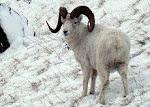Wednesday, December 1, 2010
Mule Deer
Basically there are three species of Deer in North America, Mule Deer, Whitetail Deer, and the Blacktail Deer. The Mule Deer can easily be identified by the black tip on the tail with the underside of the tail being white. The Whitetail Deer will have no black and the entire underside is comprised of white hair. Typical of them, when they run, their they stick their tail straight up in the air as a flag. The Blacktail Deer is the smallest of the deer family and will have black hair on the underside of the tail. As in most of the deer family, the males will form horns, dependent on it's age. The females or does will remain anterless. The Whitetail Buck will normally have larger antlers in circumference and they will have a wider spread. The Mule Deer Buck will typically have smaller diameter horns but they will spread and grow higher than those of the Whitetail.
I was somewhat concerned about finding a large Mule Deer Buck, I feel very fortunate to have seen several which I would classify as trophy type animals. The Mule Deer can be found throughout the western United States and some areas in Canada. In some states, the population has diminished over the past few years due to a disease inherent to the Mule Deer. However, I was fortunate to see a good number, much better than I had expected. The name of the Mule Deer is derived from it's ears, larger than the others in the deer family. Their hearing is very keen and will spook easily by an unfamiliar sound.
Subscribe to:
Post Comments (Atom)























No comments:
Post a Comment